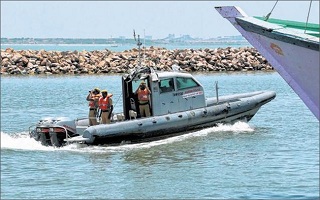The Ministry of Home Affairs has completed the modalities of setting up a new armed force — Central Marine Police Force — to strengthen coastal security. A final proposal would be sent to the Cabinet for approval, say sources. About the structure of the force, a senior ministry official said, “Unlike other Central armed police forces, the Central Marine Police Force will have it own cadre, rules, manual, Act, and infrastructure and would be headed by a Director-General rank officer.”
The proposal to constitute a Central Marine Police Force was made in mid-2016. However, it was not taken up with much enthusiasm, but with several recent intelligence inputs indicating that “Pakistan-based terrorist groups have plans to carry out attacks on important installations and cities located along the coast after infiltrating their cadre through the sea route,” the ministry expedited the move to form the armed marine force.
The official working on the constitution of the marine force, said when Rajiv Gauba was Home Secretary, he had been pushing to expedite the process and had raised the matter on several occasions during internal security meetings. Gauba is currently Cabinet Secretary.
India has a vast coastline of 7,516 km touching 13 states and union territories. It also has around 1,197 islands.
“So far, in order to strengthen coastal security, a Coastal Security Scheme has been implemented in phases since 2005, with the objective of strengthening capacity and infrastructure of the police force of the coastal states/union territories for patrolling and surveillance of coastal areas, particularly shallow areas close to the coast,” said the officer.
The Phase-I of the scheme was implemented during 2005-2011 with an outlay of Rs 646 crore. Under Phase II (2011-2020) of the scheme, an amount of Rs 1023.50 crore has been allotted for procurement of 225 new boats based on the vulnerability assessment of the coastline and a total of 60 jetties have been sanctioned for coastal states and union territories.
Under the scheme, 200 coastal police stations are operational, and coastal police has been equipped with 204 boats, 30 jetties, 284 four-wheelers, 554 two-wheelers, 97 check-posts, 58 out-posts and 30 barracks. The coastal police stations are also equipped with navigation and communication equipment, card readers, equipment enhancing night operation capabilities of boats and computer systems.
Looking into these complications, the MHA actively considered the proposal to set up a Central Marine Police Force and the concerned officers were told to “initiate action in a time-bound manner and communicate the action taken to the Prime Minister’s Office”. Currently, a three-tier coastal security ring all along the coast is provided by the State Coastal Police, Indian Coast Guard (ICG) and Indian Navy. The Indian Navy is patrolling along the International Maritime Boundary Line (IMBL), while the ICG is mandated to carry out patrolling and surveillance up to the Exclusive Economic Zone of India (EEZ) and the State Coastal Police performs boat patrolling in the shallow coastal area. The Indian Navy has been designated as the authority responsible for overall maritime security.








